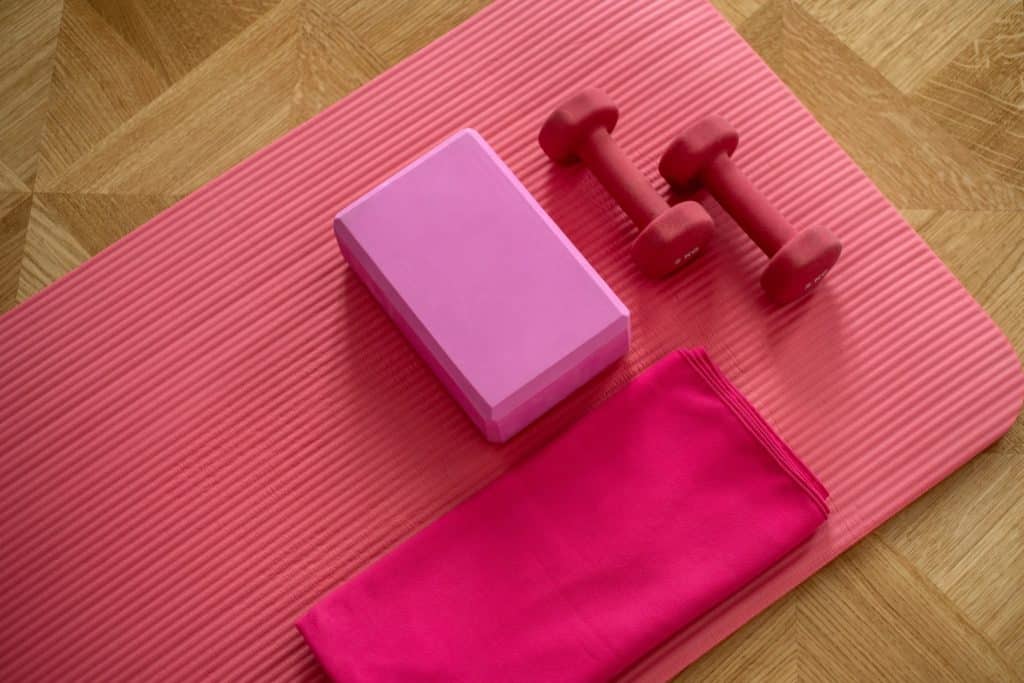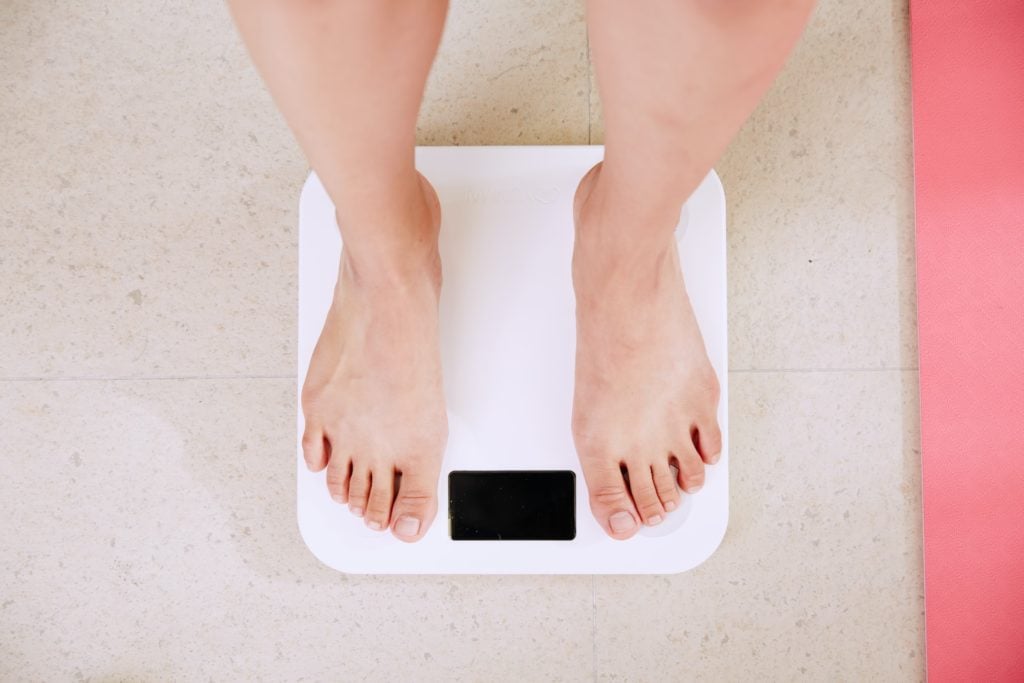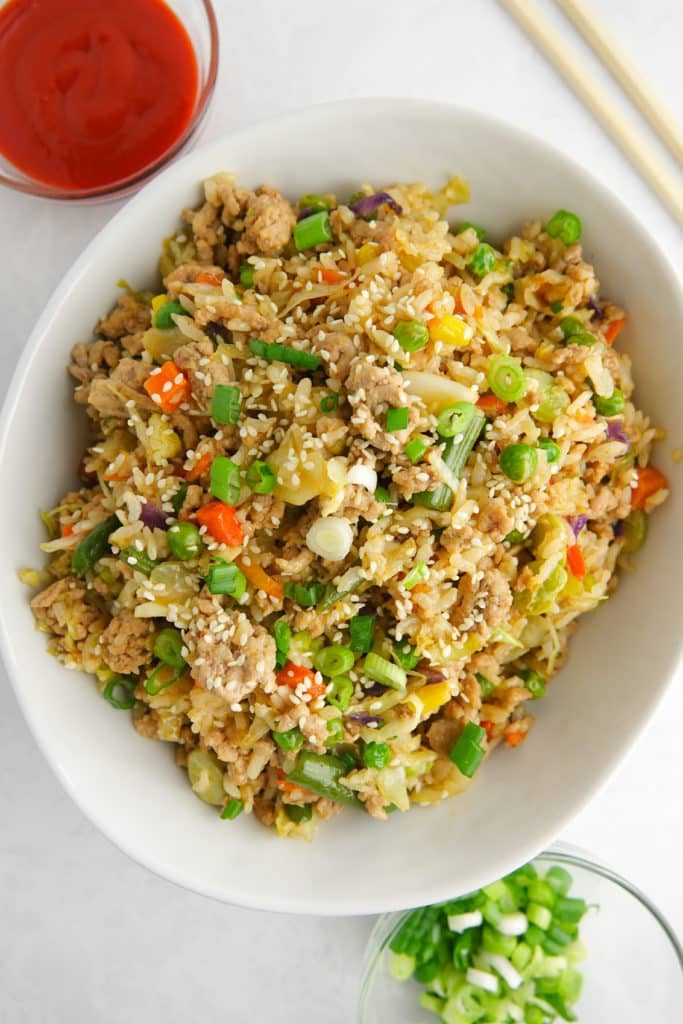How to Lose Weight Without Counting Calories (17 Tips)
Want to learn how to lose weight without counting calories?
Well, you’re in the right place! As a registered dietitian, I’m here to help make achieving your health goals easy and effortless with doable nutrition tips and simple recipes.
In this blog post, I’ll walk you through how weight loss works and 17 ways to lose weight without obsessively counting or weighing your food. Working toward weight loss goals should never feel restrictive or obsessive–so let’s talk about how to make sure of that!
And this can help too… FREE DOWNLOAD: How to build a healthy plate like a dietitian

Disclaimer about weight loss
Before we dive in too deeply, I want to offer one very important disclaimer.
I don’t believe that weight loss is the end-all-be-all for health. As women especially, I think we put far too much emphasis on the number on the scale. When we give that number too much power it can have a real impact on our sense of worth.
But, I am not here to tell you what to do. And if you have a weight loss goal, it’s important that I respect that and support it.
I’d just encourage you to let go of that ‘weight loss at all costs mentality’. If you’re like most women, you’ve tried crash diets…and they don’t last, right? They were never meant to. Unsustainable tactics really just yield temporary results.
Instead of a highly restrictive diet, let’s focus on habit change. Sound good? Let’s dive into weight loss 101.
Weight loss 101
How weight loss works
Let’s start at the beginning.
We measure the amount of fuel that we get from our food in terms of calories. Calories are a unit of energy. Calories represent how food is broken down by our bodies and used to fuel our cells and bodily functions.
At the most basic level, in order for you to lose weight, you need a calorie deficit.
This means that you need to consume less energy (through food) than you burn (through daily activity, exercise, breathing, etc.).
Calories in, calories out is true. It’s simple! But it’s not all that easy.
Is a calorie deficit possible without tracking?
Yep! A calorie deficit is most definitely required to lose weight, but that doesn’t mean you have to meticulously count calories to achieve a weight loss goal.
In fact, working on habits vs only tracking calories can mean going slower and steadier than the crash diets you’re used to. And that pace comes with a BIG benefit.
When you change things in a slow and sustainable way, you’re more likely to stick to things long enough to actually see progress.
You’re also more likely to stick to those changes so that the progress lasts. (Double WIN!)
Let’s walk through seventeen (yes, 17!) strategies you can use to promote fat loss without having to count calories or think about your process in an all-or-nothing mentality.

1) Choose minimally processed foods
Eat minimally processed, whole foods more often than highly processed foods.
Why? Minimally processed foods tend to be higher in nutrition and more filling. You can eat more of them without consuming as many calories (generally speaking), and they’ll probably keep you full for longer too. Both of which help with weight loss!
And note that I said minimally processed… not unprocessed. Most foods are processed to some degree, including nutritious foods like baby carrots and greek yogurt.
The key here is to focus more on fruits, veggies, whole grains, lean proteins, beans, nuts, etc. than you do on Doritos and ice cream.
There’s room in a healthy diet for all foods–but we want to make sure filling, nutrient-dense foods make up most of it!
PS. Convenience foods can be used to eat more healthfully too (in fact, I wrote a whole blog about eating healthy without cooking, here).
2) Choose water most often
When we have calories in liquid form – think sweetened coffee drinks, lemonade, or slushies – it is easy to consume a whole lotta calories without a timely message from our stomach to hit the brakes.
This is different from eating solid food that contains fiber, protein, or fat; those nutrients help to send the message to our brain that we’ve eaten and we’ve reached a point of being satisfied.
Choose water as your drink of choice most. Fancy coffee, sweet teas and soda are delicious, but too many of these calorie-containing drinks can make weight loss challenging.
I love this Honey Citrus Mint Tea hot or iced! There is some sugar from the added honey, but it is far less than if you were to buy a bottle of sweetened iced tea.
3) Track progress
Finding ways to monitor your progress and habits can help you stick to weight loss goals better. This is called self-monitoring.
And there are actually a LOT of ways to measure progress outside of the scale. So if weighing yourself or taking progress photos harms you more than it helps, don’t worry–you’ve got plenty of other options.
Ways to track your behaviours or progress in weight loss:
- Food Journal
- Weekly goal setting
- Minutes of movement per week
- Finding an accountability buddy
- Paying attention to how clothes fit
- Servings of vegetables eaten in a week
Monitoring these other metrics can help us to notice body composition changes as well.
If you’re building muscle (highly recommended!), you might lose fat at the same time…with no change in weight. If you only keep tabs on the scale, you’d miss this change. But if you notice how your jeans fit, you’d be able to celebrate this progress.
4) Eat more protein
Our society is pretty obsessed with protein right now.
Sometimes it’s a little excessive, I’ll admit. But the protein love is mostly for good reason!
Protein is the most satiating macronutrient, which means it helps us feel and stay full for longer and helps to prevent big spikes in blood sugar. Protein also helps curb cravings, making them feel less intense and urgent.
All great things for weight loss! And many women just don’t get enough.
Focus on high-quality, lean protein at most meals and snacks. This might include chicken, fish, lean beef, greek yogurt, eggs and tofu. You can also include plant-based protein sources such as beans, quinoa, edamame, nuts, and seeds.
5) Don’t skip breakfast
Even though intermittent fasting is pretty popular, I don’t necessarily recommend it. Especially when it means skipping breakfast.
For many people, skipping breakfast means getting so extra hungry later that we actually overeat when we finally allow ourselves a meal. Not only is that just uncomfortable, but it can hinder weight loss goals too.
Add a balanced breakfast with lots of protein and fiber to your morning routine if you aren’t doing so already.
If you struggle to make time for breakfast, consider quick and easy options like meal prep breakfast sandwiches, overnight oats, or even a simple bowl of yogurt and berries.
6) Include lots of fruits and veggies
More fruits and vegetables means more vitamins, minerals and antioxidants, of course.
But it also means more fiber, water and volume.
Fruits and veggies create bigger meals that feel voluminous with fewer calories. Which is suuuuper helpful for feeling full and satisfied as you work toward weight loss goals.
Now, don’t get it twisted. I’m not saying you should prioritize volume over everything else. And I’m not telling you to eat 3 watermelons for breakfast to curb hunger. Fruits and veggies matter for weight loss… but protein, starchy carbs and fats matter too!
If salads aren’t your thing, try fruit smoothies (banana peach, anyone?), veggie-heavy soups or a colorful stir-fry. Make sure you’re eating produce in a way you actually enjoy!
Check out my Unstuffed Egg Rolls in a Bowl recipe for a veggie-heavy dinner that is one-pan, delicious and very quick!

7) Make friends with fiber
Fiber is an important nutrient for feeling full, stabilizing blood sugar, and having more consistent energy levels.
Fiber can help you feel more mindful and in control with food, which makes weight loss without counting calories a lot easier!
Fruits and veggies are a great place to start incorporating more fiber into your meals, but they aren’t your only source of fiber. You also get a great amount of fiber from beans, lentils, whole grains, nuts, and seeds too.
Check out this article for a super long list of high fiber foods and tips for incorporating more fiber into your life. The key is going slow and aiming for variety!
Or try my Spicy Chickpea Mash for something new with a big fiber boost.
8) Understand your hunger and fullness cues
Your energy needs aren’t the exact same every single day.
Things like activity levels, sleep patterns, recent eating habits, and even your cycle can impact how hungry you feel and how much fuel you actually need.
Being in tune with your hunger and fullness cues helps you adapt to those different needs. It can help you eat enough–but not too much–in a way that’s flexible to your body and environment.
And when weight loss is a goal, this becomes even more important. Because if you eat when you’re overly hungry, you might eat too fast and too much! And if you can’t stop when you’re comfortably full, sticking to a calorie deficit is going to be difficult.
Start by identifying your hunger and fullness cues and trying to honour them better. If you have no idea what those look or sound like for you, try journaling to figure that out!
9) Learn to love leg day
Muscles are hungry tissue.
As you build muscle, your metabolic rate goes up. Your body needs more calories to maintain its function and mass as you get stronger. Pretty cool!
Exercise may also help you tune into your appetite more easily. And that’s a major win for learning to honour your fullness cues and sticking to weight loss goals!
So don’t skip leg day, or consistent opportunities to strengthen your muscles. Finding an evidence-based strength program is a great way to do this! My current fav is Evlo Fitness!

10) Find more ways to move
Part of the weight loss equation is not taking in more calories than you need.
To achieve that calorie deficit, you want to eat a little bit less than what you need consistently over time. But you can also influence how many calories you expend. Aka, moving a little bit more throughout your day!
Find ways to reduce your sedentary time and add movement to your day, without necessarily tacking on another workout.
Taking the stairs, standing while you work, and parking further from the store can help!
But: we absolutely do NOT have to earn our food through exercise! Moving more is awesome for weight loss and for health overall. But you should never try to burn off your food or compensate for indulgent treats through exercise. Okay?
11) Work on your relationship with food
A poor relationship with food can lead to overeating, inconsistency, and mental anguish… all of which can stand in the way of true health and weight loss goals.
On the flip side, a healthy relationship with food promotes consistency. It can help you let go of the all-or-nothing diet cycle where you’re constantly moving between restriction and overeating. And it can help you find a healthy weight and stay there!
The key to maintaining your relationship with food while working toward weight loss is to never (I repeat: NEVER!) sacrifice your mental peace for ‘healthy’ habits.
Keep a journal and let go of unrealistic expectations for your eating or exercise.
And remember, weight loss goals and healthy eating should support your physical and mental health. If it ever feels like it’s making it worse, it’s time to adjust your strategy!
12) Eat mindfully
It’s hard to connect with our hunger and fullness cues when we’re distracted!
Whether it’s eating lunch at your desk, enjoying dinner in front of the TV, or noshing on snacks while scrolling through TikTok… disconnection makes stopping when you’re full pretty much impossible. And in turn, it can make weight loss pretty hard too.
So turn off the distractions and pay attention while you eat! Or at the very least, limit your technology use during meals to one device.
Not only will it help you feel more satisfied after each meal and snack, it can help you stop when you’re full a lot more easily.
13) Catch those ZZZs
A good night’s sleep is not just about your beauty; it can impact your cravings too.
When you’re not getting enough quality sleep, you’re more likely to eat more the next day… and maybe crave more sweets too.
There’s so many health benefits of sleep–and it can help with gentle, sustainable weight loss too. So prioritize at least 7 hours of solid sleep per night, and make sure your daily routine (caffeine, alcohol, exercise habits) supports good rest too!
14) Eat before you’re hangry
Are you having a hard time focusing, mustering up any energy, or even being polite?
When you get to a meal overly hungry, you’re more likely to eat fast, blow past fullness cues, and end the meal eating more than you wanted or needed. Not good for your energy… and not super great for weight loss either!
Quick fix? Aim to eat every 3-4 hours. Have that next meal or snack when you notice the early signs of hunger, not when the hangry version of you is on the prowl.
15) Note unhelpful habits
What habits are getting in the way of your weight loss goals? Get into detective mode and take note of habits that might be less-than-helpful.
Get curious (try not to be too judgy)…are you snacking at night? Eating when you’re bored during the day? Forgetting to fuel after workouts?
Make note of these habits and then you can try to untangle why they’re happening to begin with.
With some helpful data and a solution-oriented mindset, you can make adjustments to your daily routine that are serving you, and your weight loss goals, better.

16) Enjoy fun foods with intention
Even if your goal is weight loss, I do NOT recommend skipping all the fun foods. That is simply a recipe for bland meals and diet burnout.
What I recommend is to enjoy the fun foods that you really love and to skip the rest.
Personally, I love a warm, gooey brownie. But I can pass on store-bought sheet cake. Figure out what fun foods bring you pleasure and satisfaction…and enjoy those mindfully!
And learn to get comfortable saying no to the rest. Fun foods are more calorie-dense, so getting pickier with them can help create that gentle calorie deficit we’re looking for.
17) Make more meals at home
Frequently eating at restaurants and relying on takeout can interfere with weight loss.
Restaurant and takeout foods tend to be higher in fat and salt. And those portion sizes? They’re pretty large too. They are also more hyper-palatable and hard to put down… and they’re more calorie-dense to boot.
Of course, eating out is delicious and easy, and it can totally have a place in a healthy diet.
But if you want to support your health and weight loss goals, making more meals at home (where you’re in charge of ingredients and portions) can help.
Key takeaways
Calorie counting can be an effective weight loss strategy, but it isn’t the only path to success.
It’s possible to lose weight without counting calories with the strategies in this post. And the great news is, focusing on these habits instead of just on points and calories can make the process more enjoyable… and the results more sustainable too.
Overwhelmed with weight loss and need somewhere simple to start? Download this freebie:
>>> FREE DOWNLOAD: How to build a healthy plate like a dietitian
Good luck with your health journey – you’ve got this!


Great guide! Thank you 🙂
Happy to help!
This is really helpful how can i save it ?
I’m so glad it’s helpful! Unfortunately there is not download currently available for the full article – but you’re welcome to bookmark the blog page to come back to whenever you need! Let me know if there’s anything else I can help with!
This was really helpful, especially the ideas around not being too critical and picking just one or two ‘cheat’ foods. Realistic and easy to follow – Thanks!
So glad you found this helpful. Thank you!